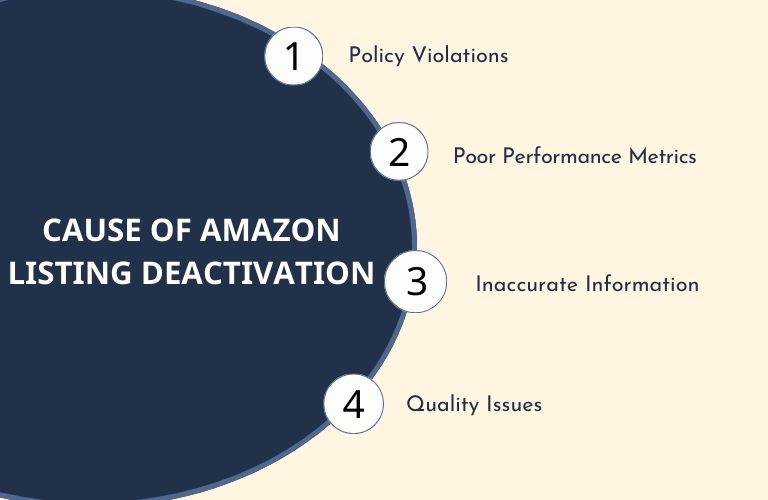Amazon Listing Deactivation is a critical challenge for sellers on the e-commerce platform. This comprehensive guide explores what Amazon Listing Deactivation entails, its causes, preventive measures, and steps to take if faced with deactivation. Additionally, it sheds light on Amazoker’s services, offering a navigation tool for sellers grappling with this issue.
What is Amazon Listing Deactivation?
Amazon Listing Deactivation involves the removal or disabling of an item or product listing from the Amazon marketplace. This process is initiated by Amazon due to several reasons, directly affecting a seller’s capacity to sell a specific item or product line.
Instances triggering Amazon to deactivate listings often revolve around policy violations, non-adherence to regulations, or concerns regarding the quality of the product. These reasons encompass a wide range of issues that may compromise the integrity of Amazon’s marketplace.
Amazon Listing Deactivation serves as a protective measure by Amazon to maintain the integrity, trustworthiness, and quality of its marketplace. It’s essential for sellers to adhere strictly to Amazon’s policies, ensure compliance with regulations, provide accurate product information, and maintain exceptional product quality to avoid the adverse impacts of listing deactivation on sales performance and their reputation on the platform.
Causes of Amazon Listing Deactivation
Amazon may deactivate product listings for various reasons, and it’s crucial for sellers to be aware of these causes to maintain compliance with Amazon’s policies. Here are some common reasons for Amazon listing deactivation:
- Policy Violations: Sellers risk listing deactivation by violating Amazon’s policies. This encompasses selling prohibited items, engaging in the sale of counterfeit products, or infringing on intellectual property rights. Any breach of these policies may lead to the immediate deactivation of listings as Amazon upholds its marketplace integrity.
- Poor Performance Metrics: Failure to meet Amazon’s performance standards is a significant trigger for listing deactivation. Metrics like the order defect rate, late shipment rate, or excessive customer dissatisfaction can prompt Amazon to deactivate the listing. Amazon emphasizes maintaining high service standards, and deviations can result in listings being disabled.
- Inaccurate Information: Deactivations can occur due to misleading or inaccurate information within product listings. Whether it’s inaccurate details, images that misrepresent the product, or any deceptive content, these can prompt Amazon to take action. Amazon prioritizes accuracy and transparency in product information to ensure a trustworthy shopping experience for customers.
- Quality Issues: Listings might face deactivation if products fail to meet Amazon’s stringent quality standards or encounter a high rate of returns due to quality concerns. Upholding a consistent level of quality is critical on the platform. Deviations from expected quality levels can result in listing deactivation to protect customer satisfaction and the platform’s reputation for quality products.

Understanding the Culprits: What Triggers Amazon Listing Deactivation?
How to Avoid Amazon Listing Deactivation
To prevent Amazon Listing Deactivation, here are detailed strategies for sellers:
- Compliance with Policies: Adhering strictly to Amazon’s policies and guidelines is paramount. Sellers must familiarize themselves comprehensively with Amazon’s regulations, encompassing prohibited items, copyright rules, and intellectual property rights. This knowledge ensures adherence and helps prevent policy violations that could lead to listing deactivation.
- Maintain Performance Metrics: Continuous monitoring of performance metrics is essential. Sellers should aim not only to meet but surpass Amazon’s standards. This involves consistent tracking of metrics like order defect rates, late shipment rates, and customer satisfaction levels. Maintaining exceptional performance is vital for a healthy record on the platform and prevents potential deactivation due to performance issues.
- Accurate Listing Information: Providing detailed, clear, and accurate information about products is crucial. This includes using high-quality images that precisely represent the product and ensuring accurate specifications. Misleading or incorrect information within listings can trigger deactivation, emphasizing the necessity for meticulous attention to detail.
- Focus on Product Quality: Prioritizing stringent quality control measures is key. Ensuring that products meet or exceed Amazon’s quality standards not only reduces returns but also upholds customer satisfaction. High-quality products generate positive reviews and lower return rates, essential factors for maintaining listing integrity and avoiding deactivation.
Implementing these strategies safeguards against potential causes of listing deactivation. By strictly adhering to policies, maintaining exceptional performance, providing accurate information, and prioritizing product quality, sellers can significantly reduce the risk of their listings being deactivated on the Amazon marketplace.
Addressing Amazon Listing Deactivation
When addressing Amazon Listing Deactivation, it’s crucial to follow specific steps to rectify the situation:
- Understand the Reason: Upon receiving a deactivation notice, carefully review Amazon’s communication. Understanding the reason behind the deactivation is vital. Sellers should thoroughly examine the notification or reach out to Seller Support for clarification on the specific violation or issue that led to the deactivation.
- Appeal Process: If sellers believe the deactivation is unjustified or an error, they can initiate an appeal through Amazon’s Seller Central. It’s essential to provide any necessary documentation or evidence supporting their case. This can include invoices, supplier information, or plans for corrective action to convince Amazon of their commitment to rectify the issue.
- Corrective Measures: Taking immediate steps to address the underlying problem is crucial. Whether it’s improving product quality, rectifying misleading information in listings, or addressing policy violations, prompt action is necessary. This demonstrates to Amazon the seller’s dedication to resolving the issue swiftly.
- Reinstatement Plan: To support the appeal process, sellers should prepare a comprehensive reinstatement plan. This plan should outline the corrective actions taken to prevent recurrence of the issue that led to the deactivation. It should also include steps to ensure compliance with Amazon’s policies and regulations. Submitting this plan during the appeal process showcases a proactive approach towards preventing future issues.

Strategies for Recovery: Navigating Amazon Listing Deactivation
By meticulously understanding the reason for deactivation, appealing with relevant documentation, taking immediate corrective measures, and presenting a detailed reinstatement plan, sellers increase their chances of successfully reinstating their listings on Amazon’s platform. These steps demonstrate accountability, commitment to compliance, and the intent to uphold Amazon’s standards, which are crucial in the reinstatement process.
Amazoker Account Reinstatement Service
Amazoker specializes in aiding sellers dealing with Amazon Listing Deactivation challenges, offering tailored services designed to navigate these hurdles effectively:
- Appeal Assistance: Amazoker provides comprehensive guidance and support throughout the appeal process. They assist sellers in crafting convincing appeals that articulate the situation effectively. Their expertise includes understanding Amazon appeal of requirements, ensuring the appeals are well-structured, persuasive, and supported by necessary documentation. Amazoker’s assistance aims to increase the likelihood of successful reinstatement.
- Compliance Solutions: To prevent future listing deactivations, Amazoker offers strategies and solutions that ensure ongoing compliance with Amazon’s ever-evolving policies and standards. They assist sellers in understanding and implementing necessary changes to align with Amazon’s guidelines, helping them avoid potential violations that might lead to listing deactivation.
- Performance Enhancement: Amazoker focuses on enhancing sellers’ overall performance on the platform. They devise and implement measures aimed at improving key performance metrics crucial for maintaining a healthy selling record on Amazon. Strategies may include optimizing order defect rates, reducing late shipment rates, and enhancing product quality. By emphasizing these aspects, Amazoker aims to fortify sellers against potential deactivation.

Amazoker specializes in aiding sellers dealing with Amazon Listing Deactivation challenges
The specialized services provided by Amazoker are tailored to address the multifaceted aspects of Amazon Listing Deactivation. Their holistic approach encompasses not only appealing and reinstating listings but also proactively ensuring ongoing compliance with Amazon’s policies and elevating sellers’ overall performance standards. This comprehensive support aims to empower sellers, mitigating the risk of future deactivations and facilitating a smoother selling experience on Amazon’s platform.
To know more about Amazoker you can visit their website: amazoker.com or call them at +1 580 262 6126. They will be happy to answer your questions and provide you with solutions.
Amazon Listing Deactivation can significantly impact a seller’s business on the platform. However, by understanding the causes, taking preventive measures, and having a strategic approach to address deactivations, sellers can navigate this challenge effectively. Amazoker stands as a resourceful ally, offering specialized services to aid in resolving and preventing listing deactivation issues, ensuring a smoother selling experience on Amazon’s marketplace.
Read more











